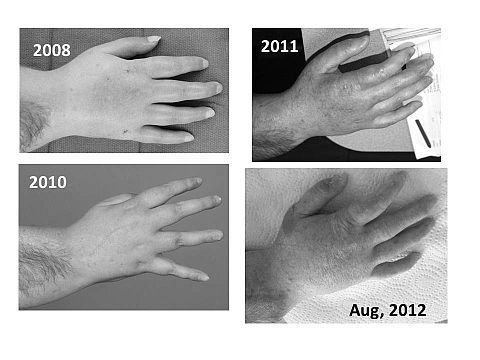Evidence for Chronic Rejection of the Skin and Adnexal Structures in a Hand Transplant Recipient at Six Years Post Transplant without Significant Graft Vasculopathy
Christine M. Kleinert Institute for Hand and Microsurgery, Louisville, KY
Kleinert Kutz Hand Care Center, Louisville, KY
Jewish Hospital Transplant Center, Louisville, KY
University of Louisville Kidney Disease Program, Louisville, KY
Meeting: 2013 American Transplant Congress
Abstract number: A848
In solid organ transplantation, all organs are afflicted to some level with chronic rejection, albeit towards different targets. Although a young field, chronic rejection in the skin of compliant patients have not been reported despite follow up times of 5 to nearly 14 years post-transplant. Our group has reported an aggressive confluent graft vasculopathy in two of our patients, and a focal non-progressive vasculopathy in all of the remaining patients. However, the skin and adnexal structures seem to be spared. Our third recipient received his unilateral graft in 2006. At year 4 post tx the patient presented with thinning of the digits and loss of fingernails. At the time over exposure to steroids was suspected. Fungal scrapings were negative and skin biopsies were negative for fibrosis. At year 5 he presented with complete loss of the nails, and thinning of the skin. The tips of the fingers appeared thinner as well, and there was a noticeable rash on the skin. X-Rays at year 4 and 6 were unremarkable for loss of bone in the digits, but loss of soft tissue especially at the tips was noted. EMG conductivity is reduced at year 6. Figure 1 shows the changes in his skin and nails between year 2 and year 6. This subject is notable for a pre-existing and stable MZL diagnosed 18 months post-transplant. DSA remains negative. The patient is also notable for 13 separate biopsies of histologic grade 2 or higher, in the face of good compliance with immunosuppressive medications. With increasing numbers of VCA recipients approaching 5 years or more post-transplant it is not surprising to find evidence of chronic rejection in the skin. What is surprising is the lack of correlation with graft vasculopathy. Further analysis is needed to determine whether this type of chronic rejection will respond to treatment.

To cite this abstract in AMA style:
Kaufman C, Marvin M, Ouseph R, Manon-Matos Y, Blair B, Kutz J. Evidence for Chronic Rejection of the Skin and Adnexal Structures in a Hand Transplant Recipient at Six Years Post Transplant without Significant Graft Vasculopathy [abstract]. Am J Transplant. 2013; 13 (suppl 5). https://atcmeetingabstracts.com/abstract/evidence-for-chronic-rejection-of-the-skin-and-adnexal-structures-in-a-hand-transplant-recipient-at-six-years-post-transplant-without-significant-graft-vasculopathy/. Accessed December 21, 2025.« Back to 2013 American Transplant Congress
